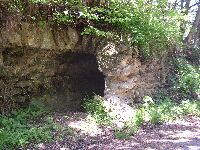
In order to maintain the shallow gradient the aqueducts did not take the most direct route, but followed the contours of the land and heading along spurs that led towards the destination. Tunnels were only built when the fall from source to destination was too slight for a longer circuit around an obstruction, like a hill or mountain. The major drawback of a surface channel was its vulnerable in peacetime (pollution, illegal tapping) and during a war (destruction, poisoning).
At the illustration a section of the Brévenne aqueduct near Courzieu / Biternay (Lyon area, France).
Extra: examples of roofs in different languages.
Almost 80% of all Roman aqueducts were laid subterranean by 'cut and cover' technique. The easiest way was 1) to dig or hew a trench, 2) to build a channel or lay down pipe, and 3) to cover it up.
For a cross-section see separate drawing.
Many aqueducts were equipped with manholes. Manholes were vertical inspection shafts which were spaced nearly always at regular intervals, one or two actus (35,5 or 71 meter) apart. They were built up to 0,7 m above ground level.
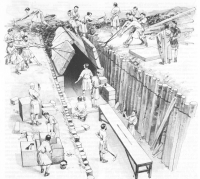
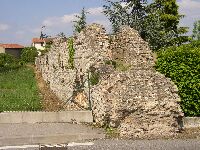
Sometimes extra walls (arcades) were built to get the right level for the conduit (left). This was only done for a height less that 2 meter. To get the aqueduct on a higher position than 2 meters, a series of arches was built. The best know examples are found in the area of Rome (right).

To prevent detours a tunnel could be necessary. For a number of reasons (to prevent lining problems - there are odd examples of miscalculations in aqueduct tunnels - to save time and to make more economic use of the labour force etc) the Romans often used the qanat way of tunnel construction in which multiple vertical shafts were dug over a hill top after which the bottom of the shafts were connected with each other. The longest Roman tunnel, as far as we know, is the Mornant tunnel in the Gier aqueduct of Lyon (France): 825 meter long. There may have been a 2250 meter long aqueduct tunnel in the Anio Novus aqueduct of Rome, using Qanat techniques.
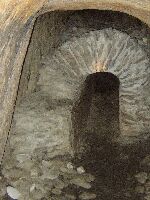
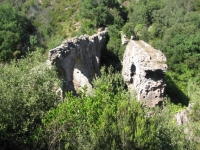
To 'bridge' a gap in the terrain and to prevent a long detour, especially to cross a valley or a river, a bridge for the aqueduct conduit was built. The highest bridge almost 50 meters above the river Gardon is the famous Pont du Gard, part of the aqueduct op Nîmes (France), but there are many more examples. In the case of the Metz aqueduct (France) a double channel crossed the Mosel river on one bridge. On the picture two almost parallel bridges in the valley of the river Le Reyran, north of Fréjus (France), one replacing the other because of stability problems.
Bridge elements in different languages.
|
Siphon One way by which natural features such as valleys and depressions could be crossed was the inverted siphon, a technique based on the simple physical principle that "water finds its own level". The Romans were well aware of this principle, as Pliny puts it (Hist. Nat. 21.57). They took advantage of this fact by constructing pipes reaching to the tops of high fountains and to supply the upper rooms of houses. On occasion the Romans would cross the lowest portion of a valley on a bridge, whether to reduce water pressure that increased with the vertical drop of the pipe, or to form a level and sturdy bed (Aicher, 1995:17). |
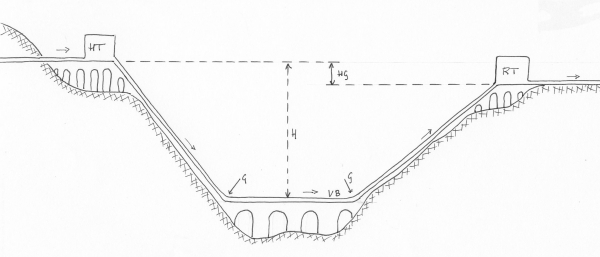 |
||||||||||||||||||||||||||||||||||||
)* the Latin word venter means belly / abdomen / buik / Bauch )** in Latin: Geniculus |
|||||||||||||||||||||||||||||||||||||